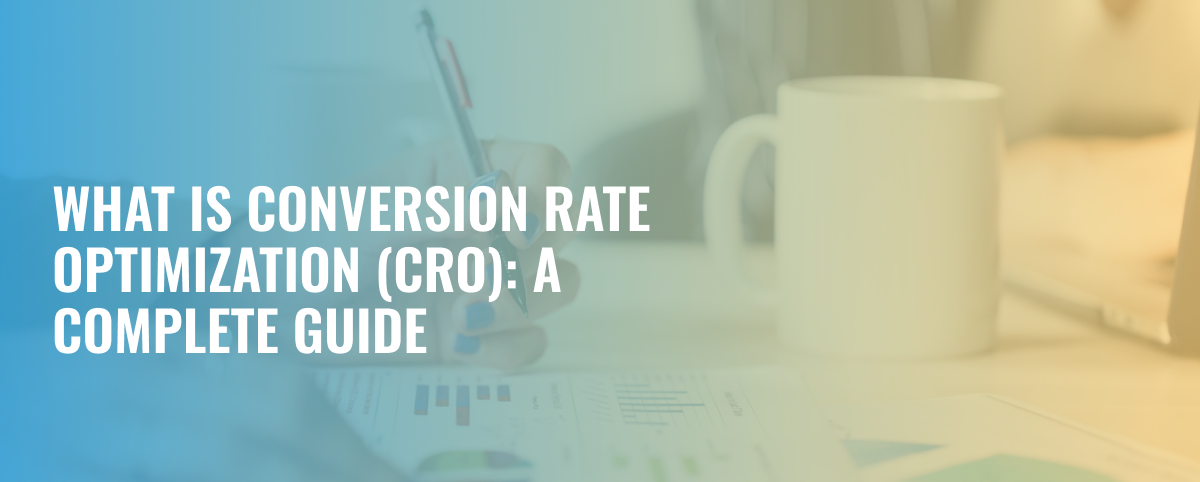8.5 minute read
What is Conversion Rate Optimization (CRO): A Complete Guide
In today’s competitive digital world, simply driving traffic to your website isn’t enough. You need to turn those visitors into actual customers or leads. This is where Conversion Rate Optimization (CRO) comes into play. CRO is the process of improving your website or landing pages to increase the percentage of visitors who complete desired actions—like making a purchase, filling out a form, or signing up for a newsletter.
In this guide, we’ll break down the key elements of CRO and how you can implement it effectively to boost your business’s bottom line.
What is Conversion Rate Optimization (CRO)?
Conversion Rate Optimization (CRO) is the systematic approach of enhancing your website to maximize the percentage of visitors that convert into customers or complete other specific actions. CRO involves understanding how users interact with your site, identifying obstacles that prevent conversions, and implementing data-driven solutions to optimize the user journey.
A conversion could be anything you define as valuable to your business. This might include:
-
Purchases
for e-commerce stores
-
Form submissions
for lead generation
-
Clicks on a specific button
like “Add to Cart”
-
Newsletter sign-ups
for content marketing
The ultimate goal of CRO is to improve your conversion rate, which is the percentage of visitors who take these desired actions.
Why is CRO Important?
You might be spending a lot of money and effort on SEO, social media marketing, or paid ads to drive traffic to your site. However, if only a small portion of that traffic converts, you’re not getting the full value of your marketing spend. CRO helps you extract more value from your existing traffic, making your marketing efforts much more cost-effective.
Imagine increasing your conversion rate from 2% to 4%—this could potentially double your revenue without needing any extra traffic. For businesses of any size, this is a huge opportunity to grow without significantly increasing marketing costs.
Key Metrics in CRO
Understanding the core metrics in CRO helps you measure progress and optimize effectively. Here are the most important metrics you should be tracking:
-
Conversion Rate
The percentage of visitors who complete the desired action.
Formula: (Conversions / Total Visitors) * 100 -
Bounce Rate
The percentage of visitors who leave the site without interacting.
-
Average Session Duration
How long visitors stay on your site.
-
Click-through Rate (CTR)
Percentage of visitors who click on a specific link or CTA (call to action).
-
Exit Rate
The percentage of visitors who leave the site from a specific page.
The CRO Process: How to Get Started
CRO isn’t a one-size-fits-all strategy. It’s a data-driven approach that involves constant testing, analysis, and iteration. Here’s how you can get started:
-
Understand User Behavior
Before making changes, you need to know how users interact with your site. Use tools like Google Analytics, Hotjar, or Crazy Egg to track user behavior, heatmaps, and scroll patterns. These tools can reveal where users drop off, which elements they ignore, and how they navigate your site.
-
Identify Barriers to Conversion
Once you have data on how users interact with your site, it’s time to identify what might be stopping them from converting. Common issues include:
- Complicated forms
- Poor mobile experience
- Confusing navigation
- Slow loading times
- Lack of trust signals (e.g., reviews, testimonials, secure payment options)
-
A/B Testing
A/B testing, also known as split testing, is the backbone of CRO. This process involves creating two versions of a webpage (Version A and Version B) and testing them to see which one performs better in driving conversions.
Elements you can test include:- Headlines
- Images
- Call-to-action buttons (CTA)
- Form fields
It’s essential to test one variable at a time to clearly understand what caused any improvement or decline.
-
Implementing Changes
After you’ve analyzed user behavior and run A/B tests, it’s time to implement the winning variations. Make sure to monitor the performance closely to ensure the changes positively impact your conversion rates.
-
Monitor and Iterate
CRO is an ongoing process. After making changes, continually monitor the data and look for further opportunities for optimization. Consumer behavior evolves, and what works today may not be as effective tomorrow.
Best Practices for CRO
There are a few tried-and-true tactics that can help boost your CRO efforts, regardless of your business type or industry:
-
Simplify Your Forms
If your site relies on lead generation forms, keep them as short and simple as possible. Each additional field you ask users to fill out increases the chance of them abandoning the form.
-
Optimize for Mobile
More than half of global web traffic now comes from mobile devices. Ensure your website is mobile-friendly, loads quickly, and offers a seamless experience on smaller screens.
-
Improve Page Speed
Page load time has a direct impact on conversions. If your site takes too long to load, visitors will leave before even considering a purchase. Use tools like Google PageSpeed Insights to optimize for faster performance.
-
Use Clear and Persuasive CTAs
Your call-to-action should stand out on the page and clearly tell visitors what to do next. Be direct, use action-oriented language (e.g., “Buy Now,” “Get Started,” “Download for Free”), and place it in a prominent position.
-
Social Proof and Trust Signals
Adding customer reviews, testimonials, and trust badges (like secure payment icons) can significantly increase conversions by building trust and credibility with your audience.
Common CRO Mistakes to Avoid
While CRO can yield impressive results, there are some pitfalls you should avoid:
-
Not having enough data
Making decisions based on insufficient data can lead to faulty assumptions. Always gather ample data before running tests or making changes.
-
Running multiple tests at once
If you’re running several A/B tests simultaneously, it can be challenging to determine which variable impacted the results.
-
Neglecting mobile optimization
Don’t optimize only for desktop users; you could miss out on conversions from mobile visitors.
Conclusion
Conversion Rate Optimization (CRO) is a critical tool for growing your online business. By making data-driven decisions and continually testing and refining your site, you can significantly increase the value of every visitor.
Whether you’re looking to increase sales, sign-ups, or inquiries, CRO ensures you’re not leaving money on the table. It’s a strategy that helps you get the most out of your existing traffic, making your business more profitable and sustainable in the long run.
Remember, CRO is not a one-off project. It’s an ongoing process of understanding user behavior, experimenting with changes, and iterating to drive better results over time.

